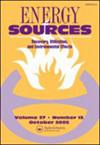Fast pyrolysis of pulverized coal at high temperatures and fuel nitrogen migration characteristics in a wire mesh reactor
IF 2.2
4区 工程技术
Q3 ENERGY & FUELS
Energy Sources Part A-recovery Utilization and Environmental Effects
Pub Date : 2023-02-20
DOI:10.1080/15567036.2023.2179693
引用次数: 0
Abstract
ABSTRACT Pulverized coal (PC) pyrolysis is an indispensable process for coal thermal conversion and utilization. The transformation of fuel-N into fast pyrolysis is a basis for the investigation of nitrogen migration in coal combustion. In this paper, a wire mesh reactor was used to study the initial decomposition processes and to reveal the final pyrolysis yield and composition distribution during the fast pyrolysis process. Furthermore, the initial pyrolysis characteristics of PC with different ash contents were presented and compared. The results showed that both Huangling coal (with higher volatile) and Wuhai coal (with higher ash content) showed a similar trend, and the pyrolysis ratio increased with the increased pyrolysis final temperature. The pyrolysis ratio at the high heating rate was estimated to exceed that at the low heating rate by 2%–10%. With the temperature increased, the char-N yield decreased first and then tended to be stable, and most of nitrogen remained in the char (more than 55%). An increase in heating rate made the pyrolysis zone to shift toward higher temperature, and it enhanced the yields of volatile and tar as well as the proportion of tar in volatile. Besides, the heating rate increased from 10°C·s−1 to 1500°C·s−1, the yield of tar-N increased from 4% to 14% and gas-N decreased from 28% to 19%. Overall, NH3 yielded was higher than HCN, which became more apparent at high heating rates. The content of the N-6 was positively related to the coal pyrolysis ratio.煤粉高温快速热解及金属丝网反应器中燃料氮迁移特性研究
摘要煤粉热解是煤热转化和利用必不可少的过程。燃料氮向快速热解的转化是研究煤燃烧过程中氮迁移的基础。本文使用丝网反应器研究了快速热解过程中的初始分解过程,并揭示了最终热解产率和成分分布。此外,还对不同灰分含量的PC的初始热解特性进行了比较。结果表明,黄陵煤(挥发分较高)和乌海煤(灰分较高)均表现出相似的趋势,热解率随热解终温的升高而增加。据估计,在高加热速率下的热解率比在低加热速率下高出2%-10%。随着温度的升高,炭氮产量先下降后趋于稳定,大部分氮残留在炭中(超过55%)。加热速率的增加使热解区向更高的温度移动,并提高了挥发性物质和焦油的产率以及焦油在挥发性物质中的比例。此外,加热速率从10°C·s−1增加到1500°C·s−1,tar-N的产量从4%增加到14%,gas-N从28%减少到19%。总的来说,NH3的产量高于HCN,这在高加热速率下变得更加明显。N-6的含量与煤的热解比呈正相关。
本文章由计算机程序翻译,如有差异,请以英文原文为准。
求助全文
约1分钟内获得全文
求助全文
来源期刊
CiteScore
4.40
自引率
6.90%
发文量
488
审稿时长
1.7 months
期刊介绍:
Energy Sources Part A: Recovery, Utilization, and Environmental Effects aims to investigate resolutions for the continuing increase in worldwide demand for energy, the diminishing accessibility of natural energy resources, and the growing impact of energy use on the environment.
You are invited to submit manuscripts that explore the technological, scientific and environmental aspects of:
Coal energy sources
Geothermal energy sources
Natural gas
Nuclear energy sources
Oil shale energy sources
Organic waste from energy use
Petroleum
Solar energy sources
Tar utilization
Sand utilization
Wind energy.

 求助内容:
求助内容: 应助结果提醒方式:
应助结果提醒方式:


